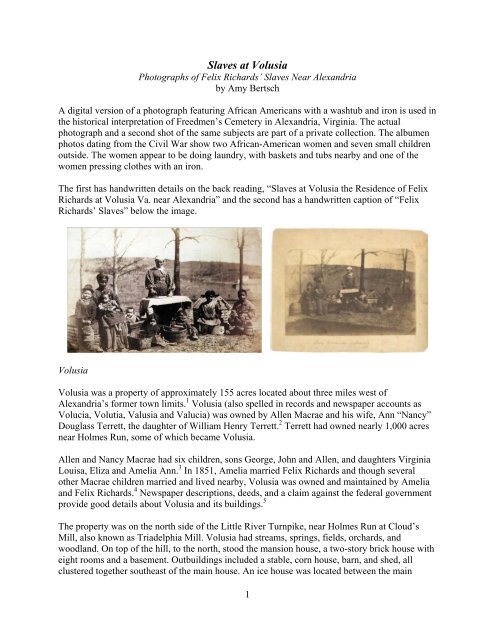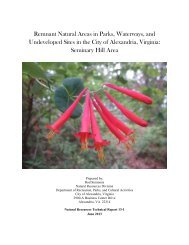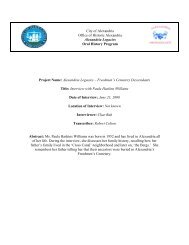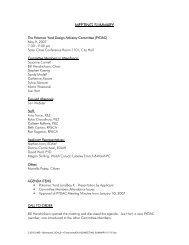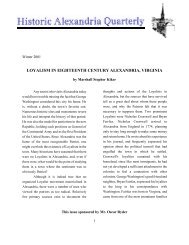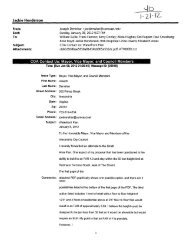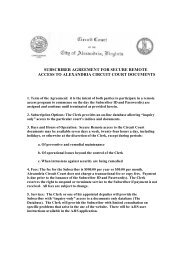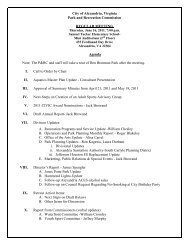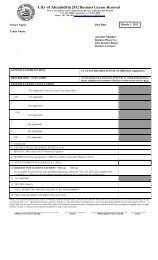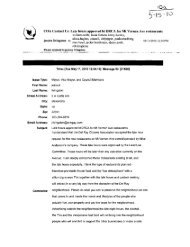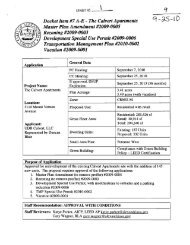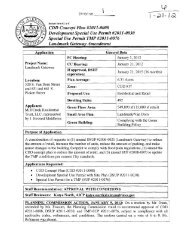Slaves at Volusia - City of Alexandria
Slaves at Volusia - City of Alexandria
Slaves at Volusia - City of Alexandria
You also want an ePaper? Increase the reach of your titles
YUMPU automatically turns print PDFs into web optimized ePapers that Google loves.
<strong>Slaves</strong> <strong>at</strong> <strong>Volusia</strong><br />
Photographs <strong>of</strong> Felix Richards’ <strong>Slaves</strong> Near <strong>Alexandria</strong><br />
by Amy Bertsch<br />
A digital version <strong>of</strong> a photograph fe<strong>at</strong>uring African Americans with a washtub and iron is used in<br />
the historical interpret<strong>at</strong>ion <strong>of</strong> Freedmen’s Cemetery in <strong>Alexandria</strong>, Virginia. The actual<br />
photograph and a second shot <strong>of</strong> the same subjects are part <strong>of</strong> a priv<strong>at</strong>e collection. The albumen<br />
photos d<strong>at</strong>ing from the Civil War show two African-American women and seven small children<br />
outside. The women appear to be doing laundry, with baskets and tubs nearby and one <strong>of</strong> the<br />
women pressing clothes with an iron.<br />
The first has handwritten details on the back reading, “<strong>Slaves</strong> <strong>at</strong> <strong>Volusia</strong> the Residence <strong>of</strong> Felix<br />
Richards <strong>at</strong> <strong>Volusia</strong> Va. near <strong>Alexandria</strong>” and the second has a handwritten caption <strong>of</strong> “Felix<br />
Richards’ <strong>Slaves</strong>” below the image.<br />
<strong>Volusia</strong><br />
<strong>Volusia</strong> was a property <strong>of</strong> approxim<strong>at</strong>ely 155 acres loc<strong>at</strong>ed about three miles west <strong>of</strong><br />
<strong>Alexandria</strong>’s former town limits. 1 <strong>Volusia</strong> (also spelled in records and newspaper accounts as<br />
Volucia, Volutia, Valusia and Valucia) was owned by Allen Macrae and his wife, Ann “Nancy”<br />
Douglass Terrett, the daughter <strong>of</strong> William Henry Terrett. 2 Terrett had owned nearly 1,000 acres<br />
near Holmes Run, some <strong>of</strong> which became <strong>Volusia</strong>.<br />
Allen and Nancy Macrae had six children, sons George, John and Allen, and daughters Virginia<br />
Louisa, Eliza and Amelia Ann. 3 In 1851, Amelia married Felix Richards and though several<br />
other Macrae children married and lived nearby, <strong>Volusia</strong> was owned and maintained by Amelia<br />
and Felix Richards. 4 Newspaper descriptions, deeds, and a claim against the federal government<br />
provide good details about <strong>Volusia</strong> and its buildings. 5<br />
The property was on the north side <strong>of</strong> the Little River Turnpike, near Holmes Run <strong>at</strong> Cloud’s<br />
Mill, also known as Triadelphia Mill. <strong>Volusia</strong> had streams, springs, fields, orchards, and<br />
woodland. On top <strong>of</strong> the hill, to the north, stood the mansion house, a two-story brick house with<br />
eight rooms and a basement. Outbuildings included a stable, corn house, barn, and shed, all<br />
clustered together southeast <strong>of</strong> the main house. An ice house was loc<strong>at</strong>ed between the main<br />
1
<strong>Slaves</strong> <strong>at</strong> <strong>Volusia</strong> Amy Bertsch<br />
house and farm buildings, and the servants’ house stood northwest <strong>of</strong> the main house, across a<br />
fence and in the wooded area.<br />
When the Civil War broke out, Union troops immedi<strong>at</strong>ely took up positions in the hills<br />
surrounding <strong>Alexandria</strong>. Several homes near <strong>Volusia</strong> were abandoned by Confeder<strong>at</strong>e supporters<br />
and destroyed by Union troops. The Richards were loyal to the Union and remained on their<br />
property, sharing it with Union troops for most <strong>of</strong> the war. Amelia recalled th<strong>at</strong> the parlor <strong>at</strong><br />
<strong>Volusia</strong> served as a headquarters <strong>of</strong> sorts and th<strong>at</strong> <strong>Volusia</strong>’s fencing, timber, tools, wagons,<br />
animals and crops were <strong>at</strong> the Union’s disposal. 6 Fifty years after the war ended and five years<br />
after Amelia died, Congress awarded the est<strong>at</strong>e <strong>of</strong> Felix Richards $5,300 for damages and losses<br />
caused by the Union army <strong>at</strong> <strong>Volusia</strong>. 7<br />
<strong>Volusia</strong> was sold, first by Amelia Richards to James P<strong>at</strong>terson in 1896, and then by P<strong>at</strong>terson to<br />
<strong>at</strong>torney Chester A. Gwinn in 1915. 8 In the l<strong>at</strong>e 1940s, as the suburbs grew following World War<br />
II, the property was acquired for construction <strong>of</strong> a 2,100-unit apartment complex and shopping<br />
center called Shirley-Duke. 9 The <strong>City</strong> <strong>of</strong> <strong>Alexandria</strong> annexed approxim<strong>at</strong>ely seven square miles<br />
from Fairfax County in 1952, property which included Shirley-Duke and much <strong>of</strong> the land<br />
around Holmes Run. Shirley-Duke became Foxchase in 1980 and is still called th<strong>at</strong> today. 10<br />
The <strong>Slaves</strong><br />
Though Union loyalists, the Richards owned slaves, as did the Macraes before them. <strong>Alexandria</strong><br />
area manumission records for John Harris in 1823, 37-year-old Linny Brown in 1841, and 24year-old<br />
Ann Brown in 1843, show all had once been owned by Allen Macrae. 11 In 1855, Felix<br />
Richards <strong>of</strong>fered a $20 reward for the capture <strong>of</strong> Sarah, a servant girl last seen <strong>at</strong> the Marshall<br />
House in <strong>Alexandria</strong>, whom Richards had purchased a year earlier in Charlottesville. 12<br />
A slave named Julia and her children, Lucinda, Henrietta, Davy, Kitty, Wilson and Levin, are<br />
identified as belonging to the Macraes in an 1843 deed <strong>of</strong> trust. 13 All but Henrietta are l<strong>at</strong>er listed<br />
in Nancy’s will in 1858; the subsequent est<strong>at</strong>e appraisal gives ages for these slaves and for three<br />
children, Jesse, Henry and William, who were born after the deed <strong>of</strong> trust was issued. 14 A birth<br />
record shows th<strong>at</strong> William was born to Lucinda in 1856. 15<br />
Nancy’s will specified th<strong>at</strong> her son George could chose either Wilson or Levin, and after a year,<br />
he could use or hire out Davy. The rest <strong>of</strong> her servants could have the “choice <strong>of</strong> their homes”<br />
either with her children or elsewhere but were not permitted to be sold outside <strong>of</strong> <strong>Alexandria</strong> or<br />
Fairfax. Nancy also st<strong>at</strong>ed th<strong>at</strong> she did not want her sons-in-law to have control over her servants<br />
and th<strong>at</strong> they would be “exclusively for the use” <strong>of</strong> her daughters. Pr<strong>of</strong>its from the hiring out <strong>of</strong><br />
her slaves would be shared with each <strong>of</strong> her grandchildren, up to $5 each per year.<br />
Certainly there were plenty <strong>of</strong> opportunities to hire out slaves. Just to the north <strong>of</strong> <strong>Volusia</strong> stood<br />
Vaucluse, the property <strong>of</strong> Thomas Fairfax and l<strong>at</strong>er the primary residence <strong>of</strong> his daughter,<br />
Monimia Fairfax Cary. Fairfax, a Swedenborgian, opposed slavery and had manumitted his<br />
family’s slaves decades earlier. However, Vaucluse relied on labor supplied by hired servants,<br />
who were simply slaves leased out by their owners. 16 While there is no evidence th<strong>at</strong> Vaucluse’s<br />
2
<strong>Slaves</strong> <strong>at</strong> <strong>Volusia</strong> Amy Bertsch<br />
servants were owned by the Macraes or Richards, the birth record for Lucinda’s son William<br />
indic<strong>at</strong>es th<strong>at</strong> she had been hired out to a J. Terrill when William was born.<br />
In her will, Nancy Macrae beque<strong>at</strong>hed specific articles <strong>of</strong> clothing to her three female slaves.<br />
Julia would receive her shawl, Kitty would receive her purple calico bonnet, and Lucinda would<br />
receive her gingham dress, aprons and a straw bonnet.<br />
A chancery suit filed in 1859 by the administr<strong>at</strong>ors <strong>of</strong> Nancy’s est<strong>at</strong>e identified another slave, a<br />
minor named Fanny. A Fairfax County court order issued in November <strong>of</strong> 1860 directed th<strong>at</strong><br />
Felix Richards would receive “Jesse, Lucinda & Child (named Fanny) <strong>at</strong> 1000 dollars.” 17 The<br />
same order divided the remaining slaves among Nancy’s other children with Julia and Levin<br />
going to John A.W. Macrae, William to Allen Macrae, David to Albert G. Gardner who was<br />
married to Virginia Louisa Macrae, and Kitty to Alexander C.N. Smets who was married to Eliza<br />
W. Macrae. Presumably Wilson was given to George Macrae who had been given the choice <strong>of</strong><br />
Wilson or Levin.<br />
Property tax records after Nancy’s de<strong>at</strong>h show th<strong>at</strong> Felix and Amelia Richards had two slaves,<br />
and careful examin<strong>at</strong>ion <strong>of</strong> those records indic<strong>at</strong>es they were likely female. In 1861 and 1862,<br />
the total number <strong>of</strong> slaves was requested for tax purposes but in 1863, the total number <strong>of</strong> male<br />
slaves was recorded; the Richards had no male slaves in 1863 after having had two slaves the<br />
previous two years. 18 Felix Richards died the following year intest<strong>at</strong>e, but, since slavery was<br />
already outlawed, it’s unlikely a will would have provided much inform<strong>at</strong>ion about his servants.<br />
According to the joint st<strong>at</strong>ement <strong>of</strong> B. Russell Barbee and Albert G. Gardner documenting the<br />
Richards’ losses <strong>at</strong> the hand <strong>of</strong> the Union Army, there were “Eleven Negroes taken away namely<br />
Frances, Lucinda, Harriet, Charles, Marshall, Martha, Julia, Mary, William, Jesse and Fanny”<br />
whose value they estim<strong>at</strong>ed <strong>at</strong> $4,000. 19<br />
The f<strong>at</strong>e <strong>of</strong> one <strong>of</strong> <strong>Volusia</strong>’s young slaves is known. Jesse became a servant to a Union <strong>of</strong>ficer<br />
whose regiment camped on the Richards’ land. According to a former <strong>of</strong>ficer with the Third New<br />
Jersey Volunteers, Jesse served Lieutenant Robert Dunham after joining their camp in August<br />
1861. He stayed with them after the regiment left Northern Virginia and died in July 1862, near<br />
Harrison’s Landing along the James River, <strong>at</strong> age 15. 20<br />
The Hughes Family<br />
Because there were no last names listed for the slaves <strong>at</strong> <strong>Volusia</strong>, loc<strong>at</strong>ing and positively<br />
identifying Julia and her children after emancip<strong>at</strong>ion is difficult. The most likely family name for<br />
them appears to be Hughes. In the 1870 census, living in <strong>Alexandria</strong>, there were 67 black women<br />
named Julia, including one Julia Hughes, age 65. 21 There were five Wilsons, including one<br />
Wilson Hughes, age 30, and there was one Levin, 25-year-old Levin Hughes. 22 Julia and Levin<br />
Hughes were living in the same household.<br />
Levin Hughes had married C<strong>at</strong>herine Williams on 17 December 1868 in <strong>Alexandria</strong>. 23 They had<br />
a daughter Henrietta and by 1880, they were living in Washington, D.C. 24 Levin’s brother<br />
Wilson was married to a woman named Anna, who was also known as Annie. Anna Johnson and<br />
3
<strong>Slaves</strong> <strong>at</strong> <strong>Volusia</strong> Amy Bertsch<br />
Wilson Hughes were married in <strong>Alexandria</strong> County (now Arlington) on 5 February 1863. 25 They<br />
l<strong>at</strong>er had several children and lived in the area <strong>of</strong> Wolfe and South Alfred streets. 26<br />
Wilson had served with the U.S. Colored Infantry during the Civil War and following his de<strong>at</strong>h,<br />
his widow Anna filed a pension applic<strong>at</strong>ion. 27 The applic<strong>at</strong>ion includes their marriage certific<strong>at</strong>e<br />
which identified Wilson’s parents as Jessie and Julia Hughes and an affidavit from Wilson’s<br />
brother, Levin. Wilson joined the service in September 1864, contracted malaria and was tre<strong>at</strong>ed<br />
<strong>at</strong> L’Ouverture Hospital in <strong>Alexandria</strong>, and was discharged from the service in July 1865. 28<br />
Julia Hughes l<strong>at</strong>er lived with a daughter in Akron, Ohio, moving there in the l<strong>at</strong>e 1870s and l<strong>at</strong>er<br />
returning to the Washington, D.C., area, where she lived with Levin in 1890. 29 Julia moved back<br />
to Akron in the 1890s and died there in 1902. 30 An article covering her de<strong>at</strong>h contained some<br />
likely exagger<strong>at</strong>ions, like her age and a memory <strong>of</strong> seeing George Washington in <strong>Alexandria</strong>, but<br />
the identific<strong>at</strong>ion <strong>of</strong> the family th<strong>at</strong> once owned her as “McCrea” is consistent with wh<strong>at</strong> is<br />
known about Allen and Nancy Macrae.<br />
A search <strong>of</strong> <strong>Alexandria</strong> and Fairfax birth, de<strong>at</strong>h, marriage and census records for the years after<br />
the war failed to yield more inform<strong>at</strong>ion about Lucinda, Kitty or Davy. But a manumission<br />
record may <strong>of</strong>fer some additional clues about the Hughes family. In 1840, a 21-year-old Jesse<br />
Hughes was freed in <strong>Alexandria</strong> by Robert Jamieson. 31 Though it is not known if this Jesse<br />
Hughes is the same person who is identified as Wilson’s f<strong>at</strong>her and Julia’s husband, it is<br />
interesting to note th<strong>at</strong> Jamieson also freed Linny Brown, a slave who had once belonged to<br />
<strong>Volusia</strong> owner Allen Macrae.<br />
Photos<br />
The owner <strong>of</strong> the two laundry day images has four other photographs taken <strong>at</strong> or near <strong>Volusia</strong>.<br />
All have the same handwriting on the back, and all six have consistent lighting and similar<br />
landscape details, like tree stumps and barren tree branches.<br />
One <strong>of</strong> them shows a small wooden structure which is described as “Lt Col Langley’s quarters<br />
NH 5 th Vol <strong>at</strong> <strong>Volusia</strong>.” In 1863, Samuel Langley recalled th<strong>at</strong> the Fifth New Hampshire<br />
Volunteers “encamped on the grounds <strong>of</strong> Felix Richards” from 2 December 1861 to 10 March<br />
1862. 32 During th<strong>at</strong> time, Colonel Edward E. Cross, commander <strong>of</strong> the Fifth New Hampshire<br />
asked Amelia Richards to allow her servant to “wash a few clothes” for him, <strong>of</strong>fering to<br />
“cheerfully pay almost any price” for the service. 33<br />
In her claim against the federal government, Amelia Richards confirms the presence <strong>of</strong> the Fifth<br />
New Hampshire <strong>at</strong> <strong>Volusia</strong> in 1862, st<strong>at</strong>ing, “Genl. Howard’s command occupied the East<br />
portion <strong>of</strong> <strong>Volusia</strong> for five months in 1862_& Col. Edward E. Cross, commanding 5 th N.H. vol’s,<br />
contracted with my husband for the delivery to his regt. <strong>of</strong> three hundred cords <strong>of</strong> wood <strong>at</strong> $4.50<br />
per cord.” 34<br />
Based on the fact th<strong>at</strong> the Fifth New Hampshire was <strong>at</strong> <strong>Volusia</strong> from l<strong>at</strong>e 1861 to early 1862, it is<br />
very likely the photo <strong>of</strong> Langley’s quarters and <strong>of</strong> Felix Richards’ slaves were taken during th<strong>at</strong><br />
time. The use <strong>of</strong> the word “slaves” to describe the subjects in the laundry day photo appears to be<br />
4
<strong>Slaves</strong> <strong>at</strong> <strong>Volusia</strong> Amy Bertsch<br />
accur<strong>at</strong>e. Slavery still existed in 1862 and according to property tax records, Felix Richards<br />
owned two slaves in 1862. He died in 1864 and slavery was abolished the following year. 35<br />
The women in the laundry day photographs are adults and both appear old enough to be mothers<br />
to the children in the photos. It is possible th<strong>at</strong> the images fe<strong>at</strong>ure Lucinda and Kitty, who were<br />
about 38 and 33, respectively, in 1862, and their children.<br />
The photographer is unknown, although a couple <strong>of</strong> possibilities deserve consider<strong>at</strong>ion. H.K.<br />
Sears, who described himself as a “Photographic Artist in Genl. Duryeas Brigade,” was <strong>at</strong><br />
<strong>Volusia</strong> in early 1862. In a letter, he recalls leaving two trunks containing clothes, books and<br />
papers in the care <strong>of</strong> Felix Richards in the spring <strong>of</strong> 1862. 36 However, the handwriting on the<br />
backs <strong>of</strong> the photos is not the same as Sears’ letter.<br />
The more likely candid<strong>at</strong>e is James E. Larkin, then a lieutenant with the Fifth New Hampshire.<br />
Larkin enjoyed a photography hobby and had photographic equipment with him when his<br />
regiment was encamped on the Richards’ property. 37 In his diary, he noted th<strong>at</strong> he had taken “18<br />
pictures <strong>at</strong> fifty cents each” on 21 January 1862. Over the next two days, he took an additional<br />
$35 worth <strong>of</strong> photos, or approxim<strong>at</strong>ely 70 images, based on his r<strong>at</strong>e estim<strong>at</strong>e. 38<br />
The subjects <strong>of</strong> some other photos are rel<strong>at</strong>ed to the Fifth New Hampshire, including the quarters<br />
<strong>of</strong> Samuel Langley, and it seems reasonable th<strong>at</strong> Larkin would have taken images <strong>of</strong> his and his<br />
comrades’ surroundings and experiences. The handwriting on the photographs has some strong<br />
similarities to th<strong>at</strong> in Larkin’s diary and letters, but it is not conclusive.<br />
Indeed, the photos are rare in th<strong>at</strong> they actually show enslaved people. Engravings and drawings<br />
<strong>of</strong> slaves in the United St<strong>at</strong>es and Caribbean from the 18 th and 19 th centuries show them <strong>at</strong> work<br />
and being punished and sold, but few photographs <strong>of</strong> slaves exist. Photography emerged as<br />
slavery was in its final years so opportunities to photograph enslaved people were limited. But<br />
the images <strong>of</strong> the slaves <strong>at</strong> <strong>Volusia</strong> show people who were enslaved <strong>at</strong> the time the photos were<br />
taken.<br />
1 Property sale notice. <strong>Alexandria</strong> Gazette, 14 Apr 1852, p. 3.<br />
2 Chapman, Sigismunda Mary Frances, History <strong>of</strong> the Chapman and Alexander Families (Dietz Printing: Richmond,<br />
Va., 1946), pp. 35-36.<br />
3 Richards, John S., letter to James W. Ballard, 9 Feb 1917, J.R. Allison v. Virginia Lee Richards, Chancery Case<br />
1917-0067, Fairfax County Court, Fairfax, Va.<br />
4 Marriage announcement, <strong>Alexandria</strong> Gazette, 29 Apr 1851, p 2. Richards, Amelia A.H., Cong. #10296, Court <strong>of</strong><br />
Claims, Record Group 123, N<strong>at</strong>ional Archives.<br />
5 Property sale notices, <strong>Alexandria</strong> Gazette, 15 Jun 1850, p. 3, and 14 Apr 1852, p.3. Fairfax County, Va., Deed<br />
Book U4:313. Richards, Cong. #10296, Court <strong>of</strong> Claims, Record Group 123, N<strong>at</strong>ional Archives.<br />
6 Richards, Cong. #10296, Court <strong>of</strong> Claims, Record Group 123, N<strong>at</strong>ional Archives.<br />
7 De<strong>at</strong>h notices, The Washington Post, 6 May 1910, p. 3. “Will Get War Claims,” The Washington Post, 5 Mar<br />
1915, p 3.<br />
8 Richards, Cong. #10296, Court <strong>of</strong> Claims, Record Group 123, N<strong>at</strong>ional Archives. “Buys the Valusia Farm,” The<br />
Washington Post, 17 Apr 1915, p. 14.<br />
9 Harness, Conrad P., “Vast Rental Program to Cover To Cover Washington With New Apartments,” The<br />
Washington Post, pp. 1R and 9R.<br />
10 “First Tenants Move Into Foxchase,” The Washington Post, 1 Nov 1980, p. E6.<br />
5
<strong>Slaves</strong> <strong>at</strong> <strong>Volusia</strong> Amy Bertsch<br />
11 Slave Manumissions in <strong>Alexandria</strong> Land Records, 1790-1863, compiled by Timothy J. Dennee,<br />
http://www.freedmenscemetery.org/resources/documents/manumissions.shtml , accessed 23 Mar 2008.<br />
12 Reward notice, <strong>Alexandria</strong> Gazette, 25 May 1855, p. 3.<br />
13<br />
Fairfax County, Va., Deed Book I:3.<br />
14<br />
Fairfax County, Va., Will Book Z:85 and Z:147.<br />
15<br />
African-Americans Births in Fairfax County, 1853-1859, transcribed by Suzannah Foster,<br />
http://www.freedmenscemetery.org/resources/documents/fairfaxbirths.pdf, accessed 30 Mar 2008.<br />
16<br />
Harrison, Mrs. Burton (Constance Cary Harrison), Recollections Grave and Gay (Charles Scribner’s Son: New<br />
York, 1911), pp. 16 and 22.<br />
17<br />
Order <strong>of</strong> Padgett, G.H., et al., 5 Nov 1860, Administr<strong>at</strong>or <strong>of</strong> Ann D. Macrae v. Allan Macrae, etc., Chancery Case<br />
1860-031, Fairfax County Court, Fairfax, Va.<br />
18 Fairfax County, Va., Personal Property Tax, 1861-1863.<br />
19 Barbee, B. Russell and A.G. Gardner, 25 Oct 1863, Cong. #10296, Court <strong>of</strong> Claims, Record Group 123, N<strong>at</strong>ional<br />
Archives.<br />
20 Collet, M.M., 14 Feb 1863, Cong. #10296, Court <strong>of</strong> Claims, Record Group 123, N<strong>at</strong>ional Archives.<br />
21 U.S. Census, 1870: <strong>Alexandria</strong> <strong>City</strong>, Va., Fourth Ward, p. 32.<br />
22 U.S. Census, 1870: <strong>Alexandria</strong> <strong>City</strong>, Va., Fourth Ward, pp. 33 and 80-81.<br />
23 Virginia Marriage Index, Grooms: 1860-1869, p. 367.<br />
24 U.S. Census, 1880: Washington, D.C., District 27, p. 39<br />
25 Virginia Marriage Index, Grooms: 1860-1869, p. 368.<br />
26 <strong>Alexandria</strong> <strong>City</strong> Directory (1876-1877), p. 89.<br />
27 Civil War Pension Applic<strong>at</strong>ion #426256, Certific<strong>at</strong>e #297032, Record Group 15, N<strong>at</strong>ional Archives.<br />
28 Civil War Pension Applic<strong>at</strong>ion #426256, Certific<strong>at</strong>e #297032, Record Group 15, N<strong>at</strong>ional Archives.<br />
29 U.S. Census, 1880: Akron, Summit County, Ohio, Third Ward, p. 63. Boyd’s <strong>City</strong> Directory <strong>of</strong> the District <strong>of</strong><br />
Columbia, 1891 (Washington, D.C., 1891), p. 534.<br />
30 Akron Official <strong>City</strong> Directory, 1899 (The Burch Directory Company: Akron, Ohio, 1899), p. 403. “Died <strong>at</strong> the<br />
Age <strong>of</strong> 109 Years, Mrs. Julia Hughes, a Typical Southern ‘Mammy’ Died S<strong>at</strong>urday Night,” Akron Daily Democr<strong>at</strong>,<br />
3 Mar 1902, p. 1.<br />
31 Slave Manumissions in <strong>Alexandria</strong> Land Records, 1790-1863, compiled by Timothy J. Dennee,<br />
http://www.freedmenscemetery.org/resources/documents/manumissions.shtml , accessed 13 Apr 2008.<br />
32 Langley, S.G., 16 May 1863, Cong. #10296, Court <strong>of</strong> Claims, Record Group 123, N<strong>at</strong>ional Archives.<br />
33 Cross, Edward E., 23 Dec 1861, Cong. #10296, Court <strong>of</strong> Claims, Record Group 123, N<strong>at</strong>ional Archives.<br />
34 Richards, Cong. #10296, Court <strong>of</strong> Claims, Record Group 123, N<strong>at</strong>ional Archives.<br />
35 De<strong>at</strong>h notice, <strong>Alexandria</strong> Gazette, 29 Oct 1864, p. 2.<br />
36 Sears, H.K., 30 Aug 1862, Cong. #10296, Court <strong>of</strong> Claims, Record Group 123, N<strong>at</strong>ional Archives.<br />
37 Pride, Mike and Mark Travis, My Brave Boys: To War with Colonel Cross and the Fighting Fifth (University<br />
Press <strong>of</strong> New England: Hanover, N.H. and London, 2001), pp. 60 and 66.<br />
38 Larkin, James E., diary entries, 21 through 23 Jan 1862, New Hampshire Historical Society, Concord, N.H.<br />
(Retrieved by Judith Ford, Dec 2009.)<br />
6


